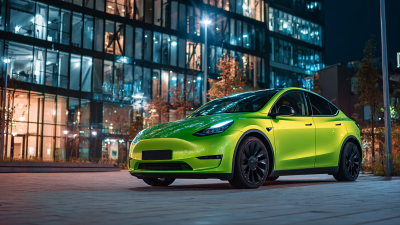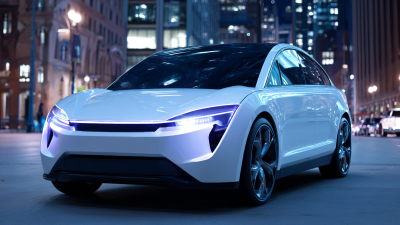As the automotive industry evolves, modern commuters are increasingly turning towards sustainable options, with Plug In Hybrid Cars emerging as a popular choice. According to a report by the International Energy Agency, global sales of plug-in hybrids reached over 2 million units in 2020, marking a substantial 40% increase from the previous year. This surge highlights a growing awareness among consumers regarding the dual benefits of reduced emissions and enhanced fuel efficiency. Plug In Hybrid Cars not only offer the versatility of both electric and gasoline power, enabling drivers to navigate long commutes with ease, but they also contribute significantly to lower carbon footprints—reducing greenhouse gas emissions by as much as 40% compared to traditional combustion engine vehicles. As urban areas become increasingly congested and climate-conscious, understanding the benefits of Plug In Hybrid Cars becomes essential for modern commuters seeking both convenience and environmental responsibility.

The rise of plug-in hybrid cars has marked a significant shift in how modern commuters approach their daily driving needs. These vehicles combine the benefits of electric and traditional gasoline engines, offering flexibility and efficiency for those navigating both city traffic and longer journeys. With the increase in plug-in hybrid sales in recent years, more commuters are recognizing that these cars can effectively meet their needs without sacrificing performance or convenience.
For those considering a plug-in hybrid, here are a few tips: first, look for models that offer an extended electric range, as this can allow for all-electric driving during your daily commute. Many new models promise up to 61 miles on a single charge, making them a great choice for short trips. Second, prioritize fuel efficiency, especially during stop-and-go traffic, where hybrids tend to excel. Lastly, consider vehicles that feature advanced tech and comfort options to enhance your commuting experience, as these enhancements can make your drives more enjoyable.
As plug-in hybrids continue to evolve, they offer commuters an appealing blend of sustainability and practicality. With advancements in battery technology and performance enhancements, these vehicles stand out as a reliable friend for modern commuting, making daily travel more efficient while reducing overall carbon footprints.
Plug-in hybrid cars (PHEVs) are rapidly becoming a preferred choice for modern commuters, and for good reason. One of the most significant advantages of PHEVs is their ability to operate on both electric and gasoline power. According to the International Energy Agency (IEA), PHEVs can achieve an average fuel economy of around 70 miles per gallon, depending on driving habits and conditions. This efficiency not only reduces the carbon footprint of daily travel but also leads to substantial savings on fuel costs, with U.S. drivers potentially saving up to $1,000 a year in gasoline expenses.

Moreover, PHEVs offer exceptional flexibility for urban commuters. A study by the U.S. Department of Energy found that over 70% of daily trips in the U.S. are shorter than 30 miles, which is well within the electric range of most plug-in hybrids. This means that many commuters can complete their daily errands using electric power alone, drastically lowering emissions. Additionally, the availability of tax incentives and rebates makes the initial investment in PHEVs more financially appealing, further driving their adoption among individuals seeking environmentally friendly yet efficient transportation options.
As more commuters seek cost-effective and environmentally friendly transportation options, plug-in hybrid vehicles (PHEVs) have emerged as a valuable solution. One of the key advantages of PHEVs is their fuel efficiency, which can significantly reduce overall commuting costs. According to the U.S. Department of Energy, PHEVs can achieve an impressive 60 miles per gallon equivalent (MPGe), making them more efficient than traditional combustion-engine vehicles. This efficiency not only translates to lower fuel expenses but also diminishes the frequency of visits to the gas station, allowing commuters to spend less time refueling and more time on the road.
In addition to fuel savings, PHEV owners can benefit from various tax incentives designed to promote green energy adoption. Current policies allow for substantial tax credits when purchasing a PHEV, which can cover a portion of the vehicle's cost. However, it's essential to act promptly, as some of these incentives may be at risk due to budgetary constraints and legislative changes. For instance, the Inflation Reduction Act initially touted as a boon for green energy, may see adjustments that could limit future savings. Homeowners and prospective car buyers should stay informed about these developments, as timely investments can lead to significant long-term savings in both vehicle and home energy efficiency.
Plug-in hybrid cars (PHEVs) present a compelling opportunity for modern commuters to reduce their environmental impact and lower their carbon footprint. By combining traditional internal combustion engines with electric propulsion, these vehicles can operate on electric power alone for shorter trips, significantly reducing greenhouse gas emissions. This shift to electric driving not only minimizes reliance on fossil fuels but also contributes to cleaner air, especially in urban areas where vehicle emissions are a major concern.
The ability to recharge PHEVs at home or through public charging stations allows commuters to maximize their electric driving range. When combined with renewable energy sources, such as solar or wind power, the carbon footprint associated with charging can be nearly eliminated. Moreover, the efficiency of plug-in hybrids means that even when the gasoline engine is in use, their emissions are typically lower than those of conventional gasoline vehicles. This dual operation makes PHEVs a practical choice for eco-conscious consumers looking to make a positive impact on the environment while still enjoying the flexibility of traditional fuel sources.

The landscape of charging options for plug-in hybrid vehicles is evolving rapidly, especially as new legislation in regions like the UK sets the stage for a robust expansion of EV infrastructure. With the government pushing for more reliable and accessible charging solutions, both home and public charging stations are undergoing significant upgrades. Recent reports suggest an increase in public charging stations, with over 940,000 now available, providing users with enhanced access and convenience while commuting. This development significantly alleviates range anxiety—one of the biggest barriers to EV adoption—by ensuring drivers can easily locate charging points during their travels.
For modern commuters, the choice between home and public charging is crucial. Home charging typically offers greater convenience, allowing users to charge their vehicles overnight from the comfort of their garages. However, advancements in navigation technology have improved the public charging experience as well; mobile applications now provide real-time data on nearby charging stations, their availability, and even their charging speeds. Reports indicate that innovations like charge-aware routing are being integrated into navigation systems, further simplifying the process for drivers by minimizing detours and ensuring they can reach their destinations with peace of mind. Balancing these options can optimize the efficiency of daily commutes, transforming the way we think about vehicle charging.





